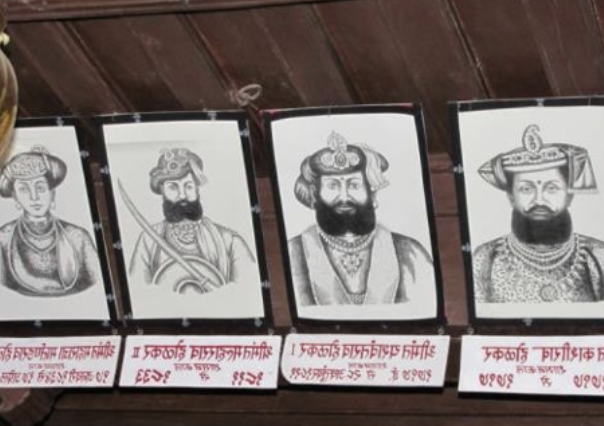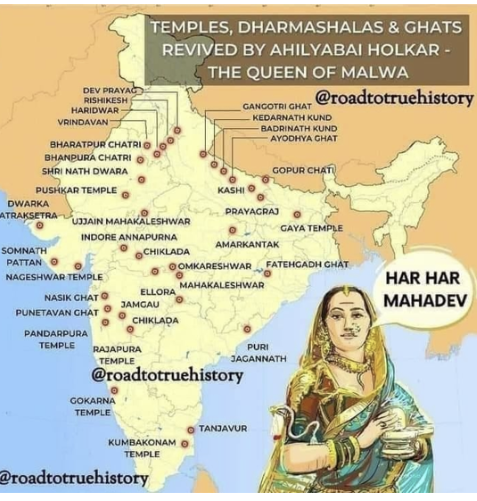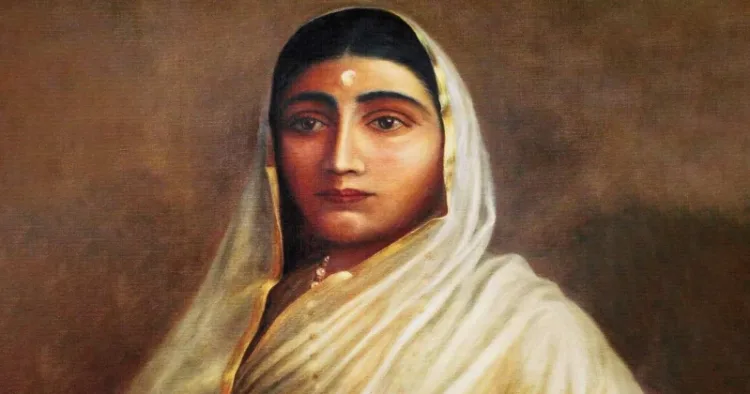On a Thursday morning in July 2024, as I sat by the window sipping my morning tea, I was disturbed by the words of Rahul Gandhi, the leader of the opposition, speaking in the Lok Sabha. His remarks on Hindus sparked a major uproar, also within my own heart and mind. Filled with a mix of anger and grief, I turned to the relief I often find in writing to channel my emotions into this insight that needed to be told.
Today, I share the story of an arduous and resilient Sanatani queen, Punyashlok Ahilyabai Holkar. In the vibrant annals of the 18th century, amidst the resurgence of Hindutva, her legacy shines brightly as an inspiration of hope and revival. Rajmata Ahilyabai was a visionary whose determination to restore and rebuild Hindu temples across Bharat marked a pivotal era of cultural and spiritual renaissance.
Rajamata Ahilyabai’s relentless efforts transcended the mere act of reconstruction and revival into a legacy and cultural identity for us Bharatiyas and future generations. Each stone placed was a testimony to her resolve to unite her people, remembering a collective identity rooted deeply in the spiritual heritage of Hindutva. She was an epitome of excellence as a statesman and administrator, dedicated her life to a profound restoration mission —from the ashes of destruction to the glory of revival.
This tale is about reconstructing physical structures and establishing pillars of Hindu faith and resilience that stand the test of time. As I pen down my feelings, it is her essence of perseverance and unwavering commitment to her roots that I wish to resonate. In Punyashlok Ahilyabai Holkar’s story, we find a historical recount and a continuous inspiration that resonates with the essence of Hindutva: rebirth, renewal, and an undying devotion to cultural preservation.
Inception of a vision

Once upon a time, in the vibrant land of India amidst the political and religious upheavals of the 18th century, a story of resilience and revival unfolded through the life of Ahilyabai Holkar. Her tale begins with her father-in-law, Malhar Rao Holkar, who dreamt of restoring the historic Vishweshwar Temple, a site of immense cultural significance for the Hindu community. This temple had been transformed into a mosque under the rule of Emperor Aurangzeb in 1669, symbolising changes that had swept through the region.
Malhar Rao’s ambitious plan to reclaim and restore the temple to its former glory was fraught with challenges. His efforts were disrupted by the Nawab of Awadh, who controlled the area and firmly opposed the demolition of the mosque. This setback delayed the dream but did not extinguish it. Years later, around 1750, the Maharaja of Jaipur picked up the mantle, attempting to resurrect the temple. He commissioned a detailed survey, hoping to navigate the complexities of land ownership and religious sensitivities. Yet, much like Malhar Rao’s efforts, this initiative, too, stumbled upon insurmountable opposition and was ultimately abandoned.
Respect for all
The torch of this enduring quest was passed to Malhar Rao’s daughter-in-law Punyashlok Ahilyabai Holkar, who in 1780 rekindled the hopes of many. Ahilyabai, renowned for her deep faith and commitment to Hinduism, approached the sensitive issue with a blend of pragmatism and respect. Rather than attempting to dismantle the existing mosque, she wisely chose to construct the new Kashi Vishwanath Temple adjacent to it. This decision prevented conflict and honoured the coexistence of diverse faiths, showcasing her adeptness in navigating complex socio-political terrains. This incident indicates the upbringing of the Hindu belief of Vasudhaiv Kutumbkam, where we Hindus consider the world as our family. Under Rajmata Ahilyabai’s watchful guidance, the new temple rose proudly in Varanasi, Uttar Pradesh. This was not just a stone-and-mortar structure but a beacon of hope and revival for the Hindu community.
Ahilyabai’s initiative was a testament to her visionary leadership. She ensured that the temple became a cherished place of worship for generations and a pivotal piece of Hindu cultural heritage.

Extension of good work
Punyashlok Ahilyabai’s contributions extended far beyond Varanasi. Her zeal led to the revival and construction of numerous temples across India, including the revered Somnath Temple in Gujarat, the Vishnupad Temple in Gaya, and the Gyanvapi Temple near the original site of the Kashi Vishwanath. Each project was a stitch in the fabric of Hindutva, reinforcing her people’s cultural and spiritual identity. She is credited with the reconstruction of hundreds of temples, including the revered sites of Kashi Vishwanath in Varanasi in 1780, Somnath Temple in Gujarat around 1783, Vishnupad Temple Gaya, Bihar in 1787, Gyanvapi Temple around 1780 CE and the Grishneshwar Jyotirlinga near Ellora, Maharashtra. These actions were not just acts of devotion but also crucial in revitalising culture and religious practices when previous rulers neglected or actively suppressed them.

Ahilyabai Holkar’s story powerfully reminds us of how dedication to one’s faith and heritage can lead to enduring impacts. Her life and legacy are a beacon of inspiration, showing that it is unnecessary to belittle a culture to show the strength of Hinduism and Sanatan Dharma. Let her story be celebrated and known, as it richly deserves, reminding us of the profound impact a single determined soul can have on future generations.
As a proud Hindu, I feel it’s vital to bring to light Bharat’s rich and glorious history, a legacy often buried through the ages. It’s a history where bravery and courage prevailed, complemented by choice for forgiveness and inclusivity.
राष्ट्रहित िी सर्वोपरी िै ।


















Comments